PTSD
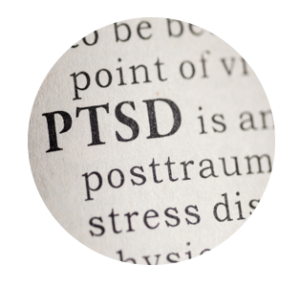 PTSD (posttraumatic stress disorder) is a mental health problem that some people develop after an extremely stressful event, like combat, sexual assault, childhood abuse, or a serious accident.
PTSD (posttraumatic stress disorder) is a mental health problem that some people develop after an extremely stressful event, like combat, sexual assault, childhood abuse, or a serious accident.
Living with the symptoms of PTSD—the upsetting memories, the sleepless nights, and the feelings of guilt or anger—can take an enormous toll on you and your loved ones. Know that help is available. The tools and resources below can help you learn about PTSD, manage your symptoms, and get started with treatment.
Videos | Online Resources | Key Research
Could It Be PTSD?
Take a short quiz—called a screener—to find out if you might have PTSD. This screener can help you decide whether it is time to make an appointment with your doctor to talk about PTSD. Only a doctor or mental health professional can tell you for sure whether you have PTSD.
The Primary Care PTSD Screen for DSM-5 (PC-PTSD-5)
Videos & Apps
-
What is PTSD?
What is PTSD?
This 3-minute whiteboard video uses hand-drawn animation to help you understand the symptoms of PTSD.
PTSD Coach Mobile App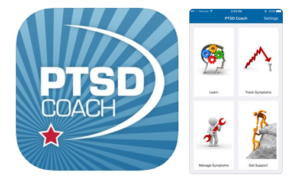
Download the PTSD Coach App for free on your Apple (iPhone, iPad, or iPod) or Android device. Use the app to track your symptoms, learn coping strategies to handle stress, and find direct links to support and help. Don’t have a smartphone or prefer to use a computer? Try the web version!
PTSD Family Coach Mobile App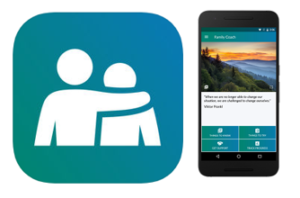
Specifically designed for concerned family members of someone with PTSD, this free mobile app offers tips on how family members can best support their loved one and tools to help family members manage their own stress.
AboutFace
Visit the AboutFace website to watch Veterans and family members describe in their own words what it is like to live with PTSD and how treatment can help. In one of our favorite videos, Laura Hendrixon, a U.S. Marine Corps Veteran talks about her experience with PTSD after military sexual trauma and explains how therapy turned her life around.
PTSD Treatment Decision Aid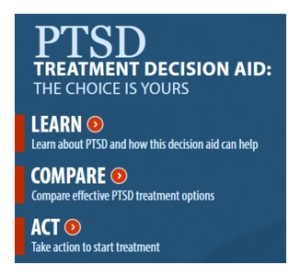
Use this interactive web-based tool to learn about PTSD treatments that work. Watch videos of providers describing different treatments, hear from Veterans who have been through treatment, and build a personalized chart to compare the treatments you like best.
Online Resources
-
The National Center for PTSD
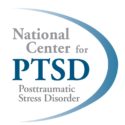 The National Center for PTSD website has information and tools to help you learn more about trauma and PTSD, manage symptoms, and find treatment. They also offer fact sheets on issues specific to women.
The National Center for PTSD website has information and tools to help you learn more about trauma and PTSD, manage symptoms, and find treatment. They also offer fact sheets on issues specific to women. -
PTSD Resources for the Military Community
Visit the Military Health System’s website to find resources related to PTSD—including assessments, videos, and more—that were developed specifically for the military community.
-
Finding PTSD Treatment Near You
Looking to get connected with PTSD treatment through the VA? Use the PTSD Treatment Locator to find services near you.
-
PTSD and the Family
PTSD doesn’t just affect the individual – it can impact the entire family. These online resources can help you understand the effects of PTSD on loved ones.
- Visit the AboutFace website to hear Veterans and family members describe in their own words the toll PTSD takes on the family.
- Visit the National Center for PTSD’s website to learn about how PTSD can affect the people you love.
- This guide offers helpful tips on how to talk about PTSD symptoms with your children.
-
The National Center for PTSD Mobile Apps
The National Center for PTSD has developed numerous self-help and educational mobile apps to support Veterans with PTSD symptoms and related health and mental health issues. The apps are compatible with both iOS and Android devices.
Key Research Findings
-
Is Prolonged Exposure effective for women Veterans with PTSD?
PTSD can result from exposure to traumatic events and is a common mental health concern for women Veterans. This study, conducted by researchers at the National Center for PTSD, examined two treatments for PTSD in women Veterans: Prolonged Exposure and Present-Centered Therapy. Prolonged Exposure is a cognitive behavioral therapy that helps people gradually confront difficult memories, feelings, and situations that they have been avoiding since the trauma. Present-Centered Therapy focuses on problems people are experiencing in their day-to-day lives and helps them figure out how to solve them.
Study Findings:
- Though both treatments reduced PTSD symptoms, Prolonged Exposure worked better than Present-Centered Therapy.
- Many women Veterans who received Prolonged Exposure no longer had PTSD at the end of the 10-week treatment and continued to be doing well six months later.
We Conclude:
- Prolonged Exposure is an effective treatment for women Veterans with PTSD.
Citation:
Schnurr, P. P., Friedman, M. J., Engel, C. C., Foa, E. B., Shea, M. T., … Bernardy, N. (2007). Cognitive behavioral therapy for posttraumatic stress disorder in women: A randomized controlled trial. Journal of the American Medical Association, 297, 820-830.
-
Can women with PTSD find relief with Cognitive Processing Therapy?
A separate study examined the effectiveness of a different type of psychotherapy for PTSD, called Cognitive Processing Therapy. This treatment teaches people skills to examine and change upsetting thoughts about the trauma. In all, 130 women participated in the study—and many of these women were Veterans. Half of the women met in person with their therapist for 12 weekly Cognitive Processing Therapy sessions. The other half attended their sessions by using video conferencing, which allowed them to see and communicate with their therapist over a video screen.
Study Findings:
- Whether they attended treatment in person or by video, women in the study showed a significant improvement in PTSD symptoms after Cognitive Processing Therapy
- Women were highly satisfied with Cognitive Processing Therapy and formed strong relationships with their therapists
We Conclude:
- Both Veteran and civilian women with PTSD can get relief from symptoms with Cognitive Processing Therapy. It is effective when patients meet in person with their therapist and when patients and therapists use video conferencing.
Citation:
Morland, L. A., Mackintosh, M.-A., Rosen, C. S., Willis, E., Resick, P., Chard, K., & Frueh, B. C. (2015). Telemedicine versus in-person delivery of Cognitive Processing Therapy for women with posttraumatic stress disorder: A randomized noninferiority trial. Depression and Anxiety, 32, 811–820. doi:10.1002/da.22397
For More Information…
For more information Prolonged Exposure, Cognitive Processing Therapy, and other effective treatments, visit the National Center for PTSD website or Ask an Expert!